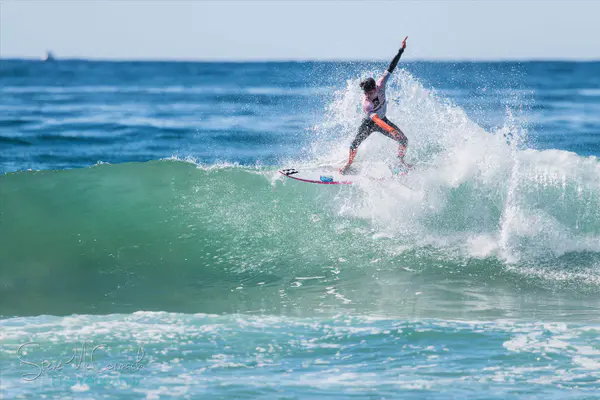Surfing is a sport that combines skill, timing, and an intimate understanding of ocean waves. One key element in surfing is the type of break, which affects how waves form and how surfers ride them. Among these types, the beach break is one of the most common and popular. This article will delve into what a beach break is, how it differs from other types of breaks, and why it’s a favorite among surfers.
Introduction to Surfing Breaks
In surfing, a “break” refers to the area where waves break or crash. The type of break significantly impacts the surfing experience. Understanding the various types of breaks is crucial for surfers of all levels.
Types of Breaks
- Beach Break: Waves break over a sandy seabed.
- Reef Break: Waves break over a coral or rock reef.
- Point Break: Waves break along a point of land.
Each type of break presents unique characteristics and challenges.
What is a Beach Break?
Definition
A beach break occurs when waves break over a sandy beach. The seabed is composed of sand rather than rock or coral, leading to different wave characteristics compared to other breaks.
Characteristics of Beach Breaks
- Sandy Seabed: The bottom of the ocean where the waves break is covered in sand.
- Variable Wave Shape: Waves can break in different ways due to the shifting sandbars.
- Shoreline Proximity: Beach breaks are typically found close to the shore.
How Beach Breaks Work
Wave Formation
Beach breaks form when ocean swells reach the shore and encounter the shallow, sandy bottom. As the swell moves into shallower water, it slows down and the wave height increases. Eventually, the wave collapses or “breaks” as it can no longer support its height.
Sandbars
Sandbars are underwater ridges of sand that affect wave formation. The position and shape of sandbars can cause waves to break in different ways.
Tides and Swell Direction
The quality and consistency of a beach break can be influenced by tidal movements and the direction of the swell.
Why Surfers Love Beach Breaks
Accessibility
Beach breaks are often located near popular beaches, making them easily accessible for surfers.
Safety
The sandy bottom of a beach break is less dangerous than rocks or reefs, making it a safer option for beginners.
Versatility
Beach breaks can produce a variety of wave types, allowing surfers to practice different techniques and styles.
Surfing Techniques for Beach Breaks
Paddle Technique
Proper paddling technique is essential for catching waves at a beach break. Surfers should use a combination of long, powerful strokes to gain speed and position themselves for the wave.
Takeoff and Drop
The takeoff is the moment when a surfer stands up on the board as the wave begins to break. The drop is the initial ride down the face of the wave. Both techniques are crucial for a successful ride on a beach break.
Maneuvers
Surfers can perform various maneuvers on beach breaks, including cutbacks, snaps, and aerials. The shifting sandbars can create opportunities for different tricks.
Challenges of Beach Breaks
- Inconsistent Waves: Beach breaks can be inconsistent, with waves varying in size and shape. This variability can make surfing more challenging.
- Crowds: Popular beach breaks can become crowded, leading to competition for waves and potential collisions.
- Sand Movement: The shifting nature of sandbars means that the characteristics of a beach break can change frequently, requiring surfers to adapt.
Famous Beach Breaks Around the World
- Pipeline, Hawaii: Although known for its powerful reef breaks, Pipeline also has a renowned beach break section.
- Trestles, California: A famous beach break that offers consistent waves and a variety of conditions.
- Bondi Beach, Australia: A popular beach break that caters to surfers of all skill levels.
See Also: What Is a Kook in Surfing Terms
How to Choose the Right Beach Break
- Surf Conditions: Check local surf reports to understand the current conditions and how they affect the beach break.
- Skill Level: Consider your skill level and choose a beach break that matches your experience. Beginners might prefer smaller, less challenging waves.
- Equipment: The type of surfboard you use can affect your performance at a beach break. A longer board may be better for catching smaller waves, while a shorter board is suitable for more advanced maneuvers.
Training for Beach Breaks
- Fitness Training: A strong core, good cardiovascular health, and flexibility are crucial for surfing. Incorporate exercises that target these areas into your training routine.
- Surfing Drills: Practice paddling, takeoff, and various maneuvers in the water to improve your skills at beach breaks.
- Safety Practices: Always prioritize safety by wearing appropriate surf gear, such as a wetsuit and a leash, and by following local surf etiquette.
Conclusion
In conclusion, beach breaks are a fascinating and accessible type of wave that offer surfers a unique riding experience. Characterized by their gentle slope and sandy bottom, beach breaks produce slower, less steep waves that are ideal for beginners or those seeking a more relaxed surfing session. Riding styles at beach breaks often involve longer boards and a flowing, drawn-out approach to maneuvers. Safety considerations, proper equipment selection, and physical fitness remain important factors for an enjoyable session.
Respect for fellow surfers and the environment are paramount to maintaining the integrity and enjoyment of beach break locations. By following guidelines of water etiquette, being mindful of marine life, and supporting coastal conservation efforts, surfers can ensure that these special places continue to thrive and provide memorable experiences for all who enter the water. Whether you’re a seasoned veteran or just starting out, beach breaks offer a fun and exhilarating way to connect with the ocean and enjoy the thrill of surfing.

